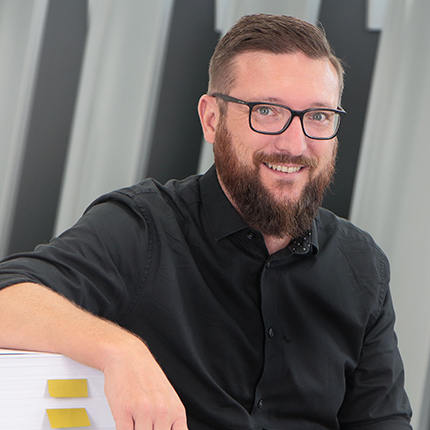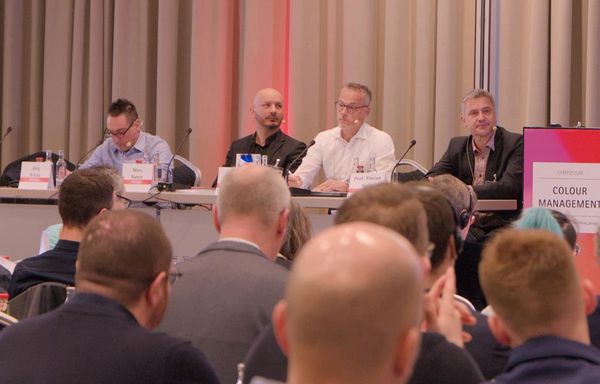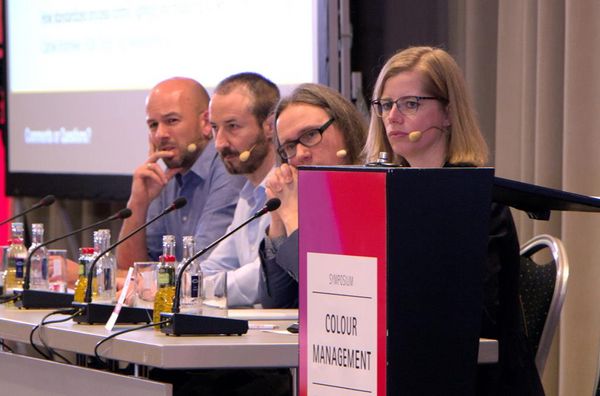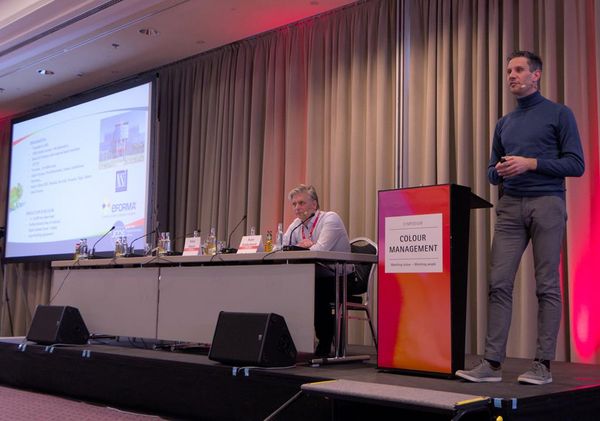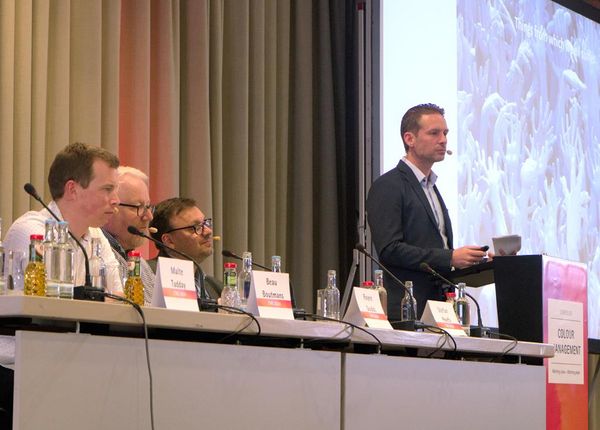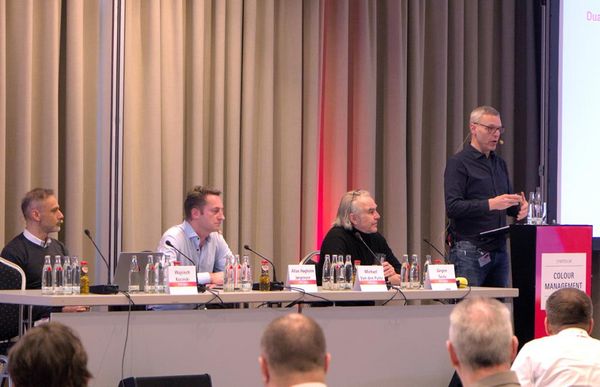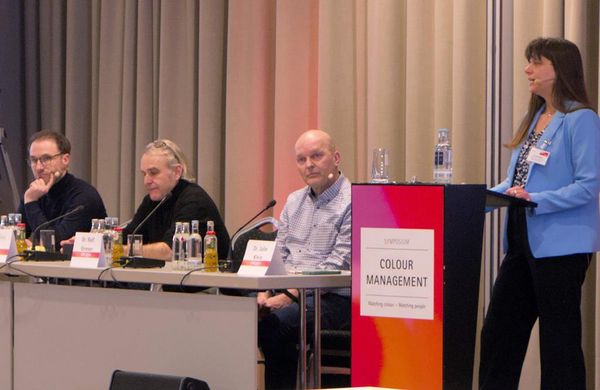Topic of your interest
Full house at the Fogra Colour Management Symposium
Press releases 03/11/2024
In seven sessions, users reported on the trend topics of customer expectations, modern workflows, print quality, packaging printing, proofing and digital textile printing. For the first time, Fogra dedicated a separate session to décor printing. The results of the first Fogra Decoration Proofing Forum (FDPF) were presented, and the Fogra stand was the place to check out the practical implementation between sessions.
There was also plenty of time to chat with speakers, exhibitors and other participants during the breaks and at the Bavarian Evening. Those interested were able to take part in short colour science experiments. In particular, the aim was to assess the streakiness and graininess of samples. The results will be incorporated into Fogra's practical research. They also form an essential basis for the master's theses of the two colour science students currently working as interns at Fogra.
Jörg Krista of Alfred Kärcher confirms that the CMS has an essential place in the colour management community: "The CMS Symposium is an important, informative event that exceeds all expectations every time. The evening meetings are also memorable. Of particular significance are the presentations dealing with practical problems and solutions.
Session 1, moderated by Prof. Florian Süßl (Berlin University of Applied Sciences), explored how to manage customer expectations from the perspective of brand owners and branded companies.
Uwe Hornung (Procter & Gamble) opened the session. He talked about colour matching for global brands. And the challenges printers face with high colour expectations.
Marc Ramet (L'Oréal) then explained the tools available for colour measurement and showed how they can be used by both experts and non-professionals, using the example of a converted iPhone spectrometer.
Jörg Krista (Alfred Kärcher) concluded the first round by explaining how the printing standard has evolved since his last presentation at CMS2022. His conclusion: colour deviations on different printers can be avoided if the target values and the Kärcher colour space are checked and measured.
Session 2, chaired by Rabea Paysen (X-Rite), focused on colour quality in modern colour workflows.
Thomas Hebes (Burda Druck) opened the session with the question of what needs to be considered when processing offset-printed products in digital printing.
Michael Guggemos (Nägele Digital Repro) then looked at the tension field of offset data in flexo printing with a digital print evaluation. He showed that ProcessStandard Digital (PSD) is an excellent approach to evaluating the achieved flexo quality.
Daniel Hobmeier (F&W Druck- und Mediencenter) explained that standardisation, from the print data with the correct output intent to the press, paper and ink, leads to a result that satisfies the customer. The conclusion: All PSO ready, all good.
Session 3 focused on high-speed inkjet for commercial, industrial and packaging. This session was introduced and chaired by Arjen Goldschmidt (Canon).
Didier Haazen (Group Joos) reported on how to define a common standard between UV offset and rotary inkjet.
The first day ended with an insight into the decor industry: How to manage colour on decorative surfaces? Stefan Hoefs (CGS Oris) chaired session 4.
Royce Dodds (Dekor8) presented the results of the first Fogra Decoration Proofing Forum (FDPF). Fogra played the role of referee, and the game rules were agreed on in advance. Relevant decors were selected, scanned and reproduced by the participating companies Metis, CGS and X-Rite. Fogra measured the originals under controlled sample conditions and compared these measurements with the reproductions (renderings and surface proofs). The world's first image distance metric defined in an ISO standard, SIM-PDE of ISO 24585, was used. It has long been established in décor printing. So "measuring in the image" is slowly becoming a reality, and Fogra plans to continue the forum due to the great interest shown.
Beau Boutmans (Unilin) explained how reliable colour references can be used to achieve consistency between digital and analogue printing.
And Malte Tadday (INTERPRINT) showed how standardisation can turn from enemy to friend in décor printing. He does not share the concern that standardisation will lead customers to produce themselves. In fact, he is convinced: "Customers only became print service providers because they were not satisfied with what they were getting".
After the official part of the first day, most of the participants joined the social event in a Bavarian atmosphere. In addition to regional cuisine, Dr Hanno Hoffstadt entertained with a talk on fluorescence. A small quiz, sponsored by GMG Color, provided a humorous finale.
The second day of the symposium was introduced by moderator Jürgen Seitz (GMG Color) in Session 5 with contract proofing and print quality in packaging printing.
The session began with Michael Van den Putte (VitraPack). He showed how brand owners can benefit from standardisation.
Allan Høgholm Jørgensen (ELOPAK) reported on extending the colour gamut by combining ECG with flexo.
Are 100% digital workflows with soft and hard proofing really possible? Wojciech Kociński (Constantia Flexibles) explained his approach and stressed that "working by numbers" is feasible.
The penultimate session focused on solutions for textile printing. Session 6 was chaired by Dr Kiran Deshpande (Siegwerk).
Mike Strickler (MSP Graphic Services) kicked things off. His topic was the colour ecosystem in digital textile printing and the improved workflow he is currently working on.
Jens Deutschman (Sachsen Fahnen) provided numerous tips and tricks for accurate profiling and explained what to look for when colour accuracy counts. He also addressed the challenges of using flags indoors and outdoors.
Heike Hafke (Vista Print) demonstrated the benefits of the newly developed FOGRA58 RGB interchangeable colour space from Fogra. Not only does it allow colours to be displayed more accurately, but it also reduces contamination and improves font quality.
Dr Julie Klein from Fogra moderated the final session 7, where interesting approaches and new trends were discussed.
Dr Ralf Grieser (Bundesdruckerei) took the audience on an excursion into the world of security documents. He vividly demonstrated the importance of colour for the machine readability of ID cards.
Jürgen Seitz (GMG Color) traced the development of colour management standardisation, i.e. the Fogra standards, and showed which points need to be clarified for future printing standards.
David Möller (4Packaging) explained the benefits of standardisation in rotogravure printing and invited everyone to participate in the new digital profile.
The dates for the next Fogra Colour Management Symposium 2026 are 25 and 26 February.
Session 1: Managing customer expectations. From left to right: Speakers Jörg Krista (Alfred Kärcher), Marc Ramet (L'Oréal), Uwe Hornung (Procter & Gamble) and moderator Prof Florian Süßl (Berlin University of Applied Sciences)
Session 2: Colour quality in modern colour workflows. From left to right: Speakers Daniel Hobmeier (F&W Druck- und Mediencenter), Michael Guggemos (Nägele Digital Repro), Thomas Hebes (Burda Druck) and moderator Rabea Paysen (X-Rite)
Session 3: High-speed inkjet, speaker Didier Haazen, Group Joos (right) and moderator Arjen Goldschmidt, Canon (left)
Session 4: Managing decorative surfaces. From left to right: Speakers Beau Boutmans (Unilin), Royce Dodds (Dekor8), moderator Stefan Hoefs (CGS Oris) and speaker Malte Tadday (INTERPRINT).
Session 5: Contract proofing and print quality. From left to right: Speakers Wojciech Kociński (Constantia Flexibles), Allan Høgholm Jørgensen (ELOPAK), moderator Jürgen Seitz (GMG Color) and speaker Michael Van den Putte (VitraPack)
Session 6: CMYK, CMYK+ & ECG. From left to right: Speakers Heike Hafke (Vista Print), Jens Deutschmann (Sachsen Fahnen), Mike Strickler (MSP Graphic Services) and moderator Kiran Deshpande (Siegwerk)
